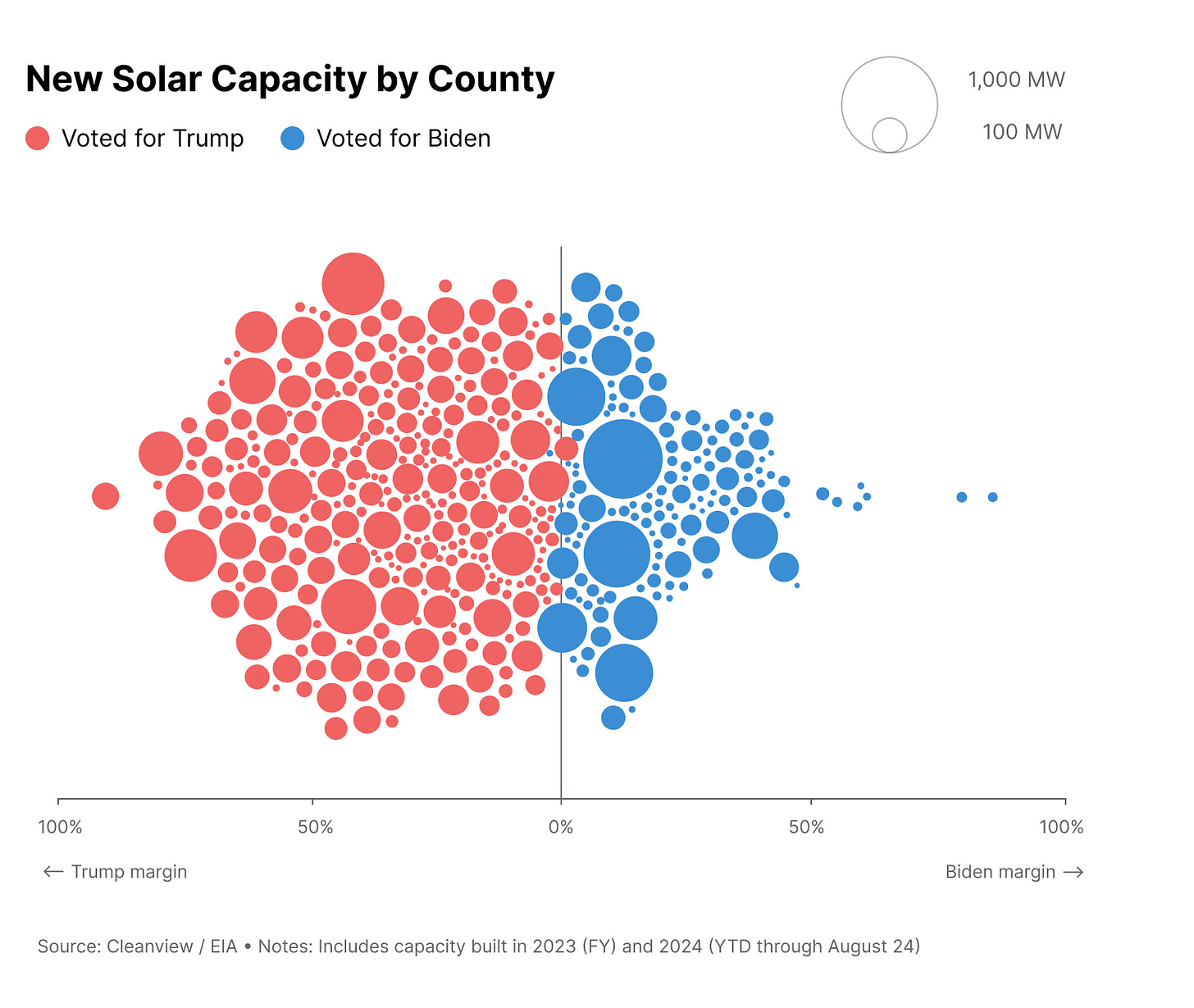Clean energy is booming in Republican counties across the U.S.
66% of new clean energy capacity has been built in counties that voted for Trump
It’s been more than two years since President Joe Biden and Congressional Democrats passed their signature climate bill, the Inflation Reduction Act. The clean energy tax credits in the bill have set off a renewable energy boom in America—and nowhere is clean energy growing more than in counties that voted for Donald Trump in 2020.
Since 2023, the country has built 56 GW of utility-scale solar, wind and battery capacity, according to data from Cleanview. 36.9 GW (66%) of that capacity has been built in counties that voted for Trump in 2020. By comparison, 19.2 GW (34%) has been built in counties that voted for Biden.
Some of the counties with the fastest clean energy growth are located in Texas, which is building more solar farms, battery storage projects, and wind farms than any other state by far. But clean energy is growing in counties across the country.
In Pinal, Arizona, a county that borders Phoenix, 910 MW of clean energy capacity has been built since the beginning of 2023. Residents in Pinal County voted for Trump by a margin of 17%.
You can use Cleanview’s free project explorer to view solar, wind, and battery projects built in Arizona.
One of the biggest projects in Pinal County came online this summer, when Orsted finished building Eleven Mile Solar Center, a hybrid project with 300 MW of solar and 300 MW of battery storage capacity that can discharge over four hours. The project will power Meta’s nearby data center.
Solar is growing fastest in red counties
Many of the country’s solar projects are being built in red counties. Since the beginning of last year, 23.7 GW of utility-scale solar capacity has been built in counties that voted for Trump, compared to 10 GW in counties that voted for Biden.
Madison, Ohio—located just outside of Cleveland—is one such county that has benefitted from the solar boom. In December 2023, EDF Renewables built one of the country’s largest solar farms when it brought Fox Squirrel Solar online in Madison. The project can generate 577 MW of electricity at peak capacity, enough to power tens of thousands of homes.
Just a month later, another 180 MW solar project came online in Madison. Today the county has roughly one gigawatt (1,000 MW) of solar capacity. Residents in Madison voted for Trump in 2020 by a margin of 41%.
Want to track clean energy projects in real-time? Cleanview’s project tracker helps organizations track solar, wind, and battery projects at every stage from permitting to final construction. Learn more by signing up for a demo of the platform.
Or view recently built solar, wind, and battery projects in Ohio using the free project explorer tool.
88% of wind projects are being built in red counties
Wind projects are even more likely to be built in red counties. Since the beginning of last year, 8.6 GW (88%) of wind capacity has been built in counties that voted for Trump, compared to 1.1 GW (12%) in counties that voted for Biden.
These trends can be explained, in large part, by population density. Fewer people means less local opposition and cheaper land, essential requirements for developers that want to build clean energy megaprojects.
Republic, Kansas is home to the most new wind capacity in the country. In December 2023, NextEra Energy built High Banks Wind in the county. The 643 MW project will power a Google data center in neighboring Nebraska. It is the third largest wind project in the country.
The county of Republic has a population density of 6.5 people per square mile. For comparison, New York County—home to Manhattan—has a population density of 69,468 people per square mile.
View more wind farms built in Kansas
Most batteries are being built in blue counties
Unlike solar and wind projects, most battery storage projects are being built in blue counties near major population centers.
Since the beginning of 2023, developers have built 12.5 GW of new battery storage capacity. 8 GW (64%) has been built in counties that voted for Biden in 2020. 4.5 GW (36%) has been built in counties that voted for Trump.
Batteries require far less land than solar and wind projects. As a result, they can be sited in relatively dense population centers like Los Angeles County, which is home to 228 MW of new battery storage capacity.
Dense counties and city centers are more likely to vote for Democrats. They are also places with high electricity demand and subsequently high peak power prices, which explains why battery developers are flocking to these hubs.
In Maricopa, Arizona—home to Phoenix—11 battery projects have been built since the beginning of 2023. These projects have a combined capacity of roughly 1 GW (1,000 MW) and 4 GWh (4,000 MWh).
View battery projects in California and Arizona
The renewable boom is touching counties across the U.S.
While some areas of the country are seeing more clean energy growth than others, the renewable boom is touching all corners of the country. Since 2023, clean energy projects have been built in 529 counties in states everywhere from Florida to Maine to Alaska.
Clean energy may still be a partisan issue in Congress, but its benefits are touching Americans across the political spectrum.
Explore the data from this story for yourself
Want to see which counties are building the most clean energy? Check out interactive versions of the charts in this story here.
Cleanview tracks thousands of clean energy projects across the country at every stage from permitting to final construction. To learn more sign up for a demo of the platform below.





